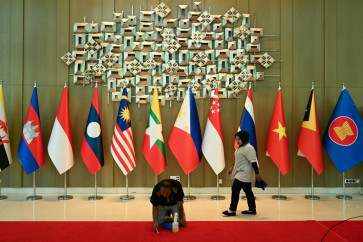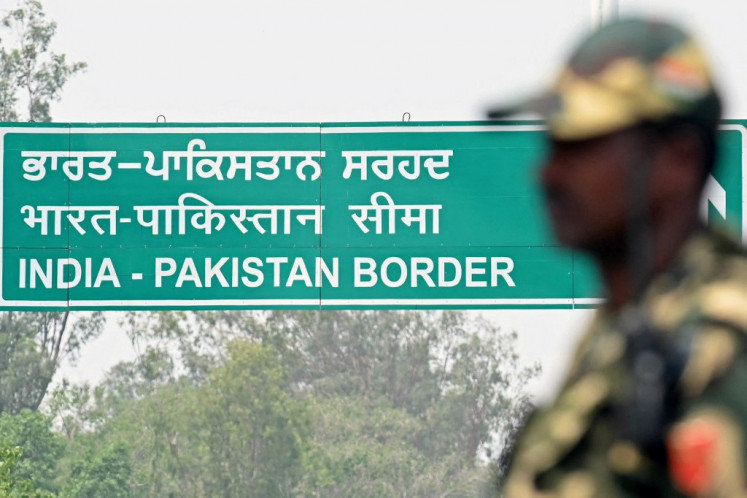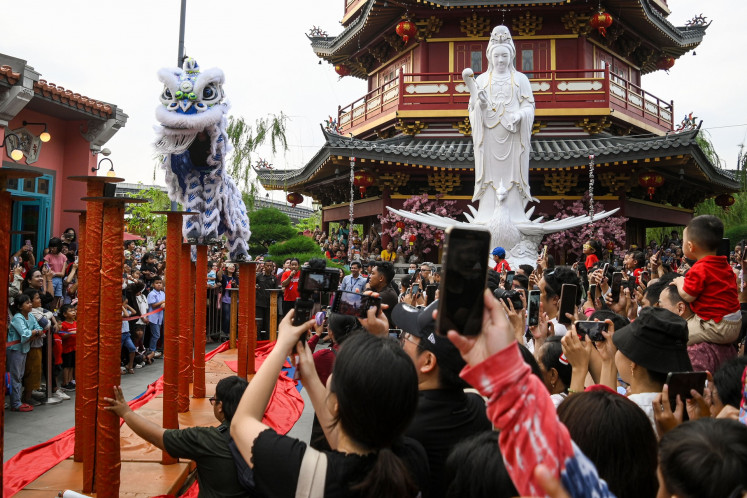Bunaken Island: A return to the beauty of the deep
Lekuan III site
Change text size
Gift Premium Articles
to Anyone

Lekuan III site. JP/Arief Suhardiman
"Let's dive!" my dive guide Kennedy exclaimed the moment we set foot on Bunaken Island, an underwater mecca just off the coast of Manado in North Sulawesi.
It seemed he did not want to waste any time. Plunging into the deep, we were soon welcomed by thousands of small fish, from Butterflyfish to Angelfish and Triggerfish, swimming around us in every direction.
You can't always find such a diverse range of fish species at just one dive site. Lekuan II and Lekuan III are two of the best sites in the vast Bunaken National Marine Park in North Sulawesi, which is widely regarded as one of the best tropical dive regions in the world. One of the most memorable moments during my first visit to Bunaken four and a half years ago was having my dive mask "kissed" by hundreds of little fish.
Near the surface, the clear, calm conditions allowed me to see the stark contrast between the bodies of water surrounding Bunaken Island. On one side of the "Great Wall", a steep volcanic structure teeming with marine life, the dark blue waters plunge off into nothingness while on the other side, the crystal turquoise shallows indicate the presence of soft and hard corals.
The wall has long been considered a top dive site due to the abundance of corals and sea critters but also because it remains quite a challenge. At most dive sites, one must get close to the sea bed to get a good look at the coral gardens and creatures, but Bunaken's vertical wall diving offers something entirely unique.
Diving at the Lekuan II site feels like flying alongside the edge of a skyscraper. The beauty of the wall is laid bare for divers to enjoy - corals and sea plants are perfectly structured like in an art gallery.
Other than soft and hard corals, the vertical wall offers columns where fish live in species groupings. They often reside in overhangs, which are sections of the wall that have grown upward.
We dived along the wall until we reached a depth of 30-meters. Luckily, the relatively calm conditions provided visibility of around 25-40 meters, enhancing the colorful scenes before us.
While drifting - a style of diving where you follow the current - I saw thousands of fish 'dancing' to the pulse of the oceans movements. A Clownfish, guarding the tentacles of an anemone, swam in and out of its colorful house. A few Bannerfish with yellow, white and black stripes calmly circled a sea fan coral.
At this depth, we were also blessed with spotting a green turtle resting on a large coral structure. When it swam gently across the great wall, my first reaction was to approach it, but I reassessed my choice not wanting to scare it away.

Having got a snap of this giant creature of the deep, I saw a school of Jackfish (Trevally) known by locals as ikan bobara. Their bodies were shining with a silverly sheen in the water. A 1.5-meter tuna gigi anjing (Dog Tooth Tuna) also swam by gallantly.
No sooner had the tuna left my view than I came across another giant fish of the sea, the Napoleon Wrasse. It was more than a meter long and guarded by hundreds of small Triggerfish. Due to the distance, I didn't manage to get a shot, but was satisfied enough to surface from my first dive at Lekuan II.
On the boat, Kennedy said the Napoleon Wrasse were on the verge of extinction because of illegal fishing.
"That [illegal fishing] is still rampant here," he said.
The high demand for Napoleon Wrasse on overseas markets lures fishermen to hunt rare fish.
"Taiwan and Hongkong markets are willing to pay high prices for this kind of fish. And local fishermen usually sell their catches to foreign ships they meet at sea, so they don't have to sell them at local markets," Kennedy said.
For my one-hour surface interval break, I had some lunch and prepared for the second dive, this time at Lekuan III just adjacent to the prior site.
This time the sea was filled with a richness of small fish like Anthias and Fairy Basslet, which are very friendly species to divers. Just like at Lekuan II, we did vertical wall diving. At this site we could see a small canyon.
On both sides of this incredible structure rested sea fan corals and Feather Stars. I could also spot Napoleon Wrasse and Bumphead Parrotfish swimming casually among some sea whips.
But my eyes were soon drawn to a whitish-blue creature glued to a soft coral. Upon closer inspection, it turned out to be a Nudibranch - the gem for macro photographers. Spotting a school of Orbicular Batfish, I eventually called it a day.

Emerging from the water, we were taken aback by the presence of garbage and pollutants on the surface of the water. Plastic bottles, instant noodle packages and plastic straws were like a carpet across the surface. This was not the kind of thing you want to remember from your dive trip.
A few days before embarking for the island I walked along the coastline at the Manado Boulevard and noticed it was covered with plastic waste. It appeared that the waste washing up at Bunaken Island was coming directly from Manado city.
"Many people are ignorant when it comes to dumping waste in the sea. They don't understand that plastic can hurt coral reefs. Pollution blocks the sun from penetrating the sea where coral reefs live. Without the sun, sooner or later the coral reefs will die," Kennedy said.
But plastic waste is one of many environmental problems afflicting the area. A massive reclamation project along the beach at the Manado Boulevard is an eyesore. By comparison, 4.5 years ago I could see the beach from the highway, but now all that is visible are the stoic structures of shops and offices.

I could see the development from Bersehati Manado harbor reaching to Manado Convention Center - one of the venue for the World Ocean Conference (WOC) and the Coral Triangle Initiative (CTI) Summit recently - area.
Lisa, a German who has dived in Indonesian waters for the past 15 years, said she was worried about the rate of construction along Manado beach.
"Manado used to be the benchmark of marine biodiversity. I used to compare it to every place I visited. Well, now I am comparing Manado to what it used to be like 15 years ago, I'm disappointed to see less marine life and coral. Instead of boosting eco-tourism, the government is killing it with this land reclamation," she said.
"Now I have to find a new destination that can replace what Manado used to be like."
Heaven forbid the waters of Manado end up like the Seribu Islands off Jakarta Bay, a very possible reality if these reclamation projects continue. However, I still have high hopes that events like the WOC and the CTI Summit will help save Bunaken Island from any further damage.









